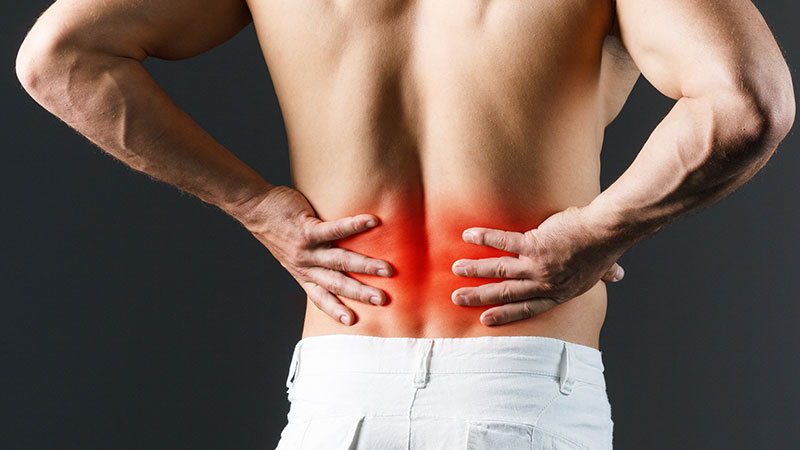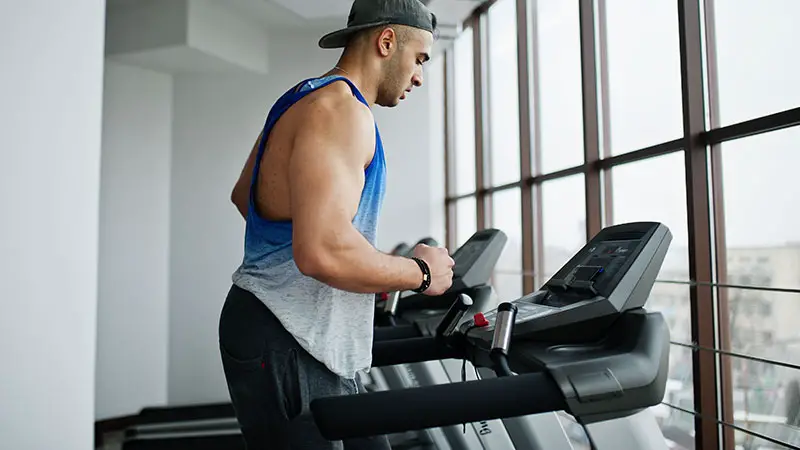Feeling discomfort in your hips after a treadmill session can be a red flag signaling the need for a break.
The pain could stem from various sources like an inflamed bursa, an irritated tendon, or a strained muscle, indicating potential damage if ignored.
Pushing through the pain might prolong your recovery time and sideline you from your workout routine.
To kickstart your healing process, it’s crucial to rest your hips and apply ice to reduce inflammation. Avoid activities that exacerbate the pain and follow a regimen of ice and heat therapy.
Seeking guidance from a physical therapist can provide advanced care if the discomfort persists. Remember, taking it easy with a gentle treadmill walk can help prevent future issues and ensure a smoother workout experience.

Common Causes of Hip Pain after Treadmill Use
Hip pain after treadmill use can stem from various factors, including improper biomechanics, overuse, or underlying conditions.
Here are some common causes:
Overuse and Repetitive Stress
When you walk on a treadmill frequently or for extended periods, your hip muscles can experience overuse, leading to strain and pain.
The repetitive stress placed on your hips without adequate rest can result in inflammation and discomfort. If you feel aches, pains, or stiffness in your hips, especially during or after treadmill sessions, it may be a sign of overuse and repetitive stress.
To address overuse and repetitive stress-related hip pain, consider incorporating sufficient rest periods into your workout routine. It’s essential to allow your hip muscles time to recover and repair.
Additionally, icing the affected area several times a day can help reduce inflammation and provide relief. If the pain persists, seeking guidance from a physical therapist may be beneficial to prevent further complications.
Poor Walking Form and Technique
Your walking form and technique play a crucial role in preventing hip pain after using a treadmill. Incorrect posture or improper walking mechanics can put excess pressure on your hip joints and muscles, leading to discomfort and potential injuries.
If you notice hip pain while walking on a treadmill, it may be linked to poor form and technique.
To improve your walking form and technique, focus on maintaining proper posture, engaging your core muscles, and ensuring that your strides are balanced and natural.
Avoid overstriding or twisting your hips excessively during each step. By correcting your walking form, you can reduce the strain on your hips and minimize the risk of pain and injuries.
Inadequate Footwear
The type of footwear you use while walking on a treadmill can significantly impact your hip health. Wearing inappropriate or worn-out shoes can contribute to hip pain due to lack of proper support and cushioning.
When your feet lack the necessary stability and shock absorption, the impact of each step can transfer excessive stress to your hips, leading to discomfort.
To address hip pain caused by inadequate footwear, invest in supportive, cushioned shoes designed specifically for walking or running.
Proper footwear can help distribute the impact of your steps more evenly and reduce the strain on your hip joints and muscles.
Ensuring that your shoes fit well and provide adequate arch support is essential for preventing hip pain during treadmill use.
Pre-Existing Conditions
If you have pre-existing musculoskeletal conditions or issues related to your hips, walking on a treadmill may exacerbate the discomfort.
Conditions such as arthritis, bursitis, or previous hip injuries can flare up during treadmill use, causing pain and limitations in movement. It’s crucial to consider your existing health conditions when experiencing hip pain after walking on a treadmill.
If you suspect that your hip pain is linked to a pre-existing condition, consult with a healthcare provider or a physical therapist for a thorough assessment.
They can provide personalized recommendations and interventions to manage your condition and alleviate the discomfort during treadmill sessions.
Adapting your exercise routine to accommodate any pre-existing hip issues can help prevent further aggravation and promote overall hip health.
Symptoms That Accompany Hip Pain from Treadmill Walking

Hip pain from treadmill walking can be accompanied by various symptoms depending on the underlying cause.
Here are some common symptoms that may accompany hip pain:
- Persistent or worsening pain that doesn’t improve with rest.
- Swelling, tenderness, or warmth around the hip joint.
- Difficulty bearing weight on the affected hip.
- Pain that radiates down the leg or into the back.
- Noticeable changes in your gait or walking pattern.
- Numbness or tingling sensations in the hip or leg.
Prevention Tips for Hip Pain While Using a Treadmill
Preventing hip pain while using a treadmill involves addressing factors like biomechanics, muscle strength, flexibility, and overall exercise habits.
Here are some tips to help prevent hip pain:
Proper Warm-Up and Cool-Down Routines
To prevent hip pain when walking on a treadmill, it’s essential to start with a proper warm-up routine. Engage in light cardiovascular exercises like brisk walking or gentle jogging for about 5-10 minutes to prepare your muscles for the workout.
After your treadmill session, don’t skip the cool-down. Gradually reduce your speed and walk slowly for a few minutes to help your body transition back to a resting state. These routines can help prevent muscle stiffness and reduce the risk of hip pain.
Choosing the Right Shoes
Selecting the right footwear is crucial in preventing hip pain during treadmill workouts. Opt for shoes with adequate cushioning and support to absorb the impact of each step.
Proper running or walking shoes with good arch support can help maintain proper alignment and reduce stress on your hips.
Avoid old or worn-out shoes, as they may not provide the necessary support, increasing the likelihood of discomfort and pain.
Treadmill Settings and Walking Posture
Adjusting the treadmill settings and maintaining proper walking posture can significantly impact your hip health. Make sure the treadmill is set at a slight incline to reduce strain on your hips and improve muscle engagement.
When walking, keep your posture upright, shoulders relaxed, and core engaged. Avoid leaning forward or backward excessively, as this can lead to added pressure on your hips.
Remember to take short, comfortable strides to reduce impact on your joints and muscles, ultimately minimizing hip pain during and after your treadmill workout.
Home Remedies for Hips Hurt After Running on Treadmill

Managing minor hip pain at home often involves a combination of self-care strategies to alleviate discomfort and promote healing.
Here are some home remedies you can try:
Stretching Exercises for Relief
Engaging in stretching exercises can help alleviate minor hip pain after walking on a treadmill. Try incorporating hip flexor stretches, piriformis stretches, and hamstring stretches into your routine.
These exercises can improve flexibility and reduce tension in the hip area, promoting relief and enhancing your overall comfort.
Rest and Ice Therapy
Rest and ice therapy are essential home remedies for managing minor hip pain. After walking on the treadmill, allow your body to rest and recover.
Applying an ice pack to the hip area for 15-20 minutes can help reduce inflammation and soothe discomfort. Remember to give yourself adequate time to rest between workouts to prevent further strain on your hips.
FAQs
Is it normal to experience hip discomfort after using a treadmill?
Yes, it is common to experience hip discomfort after using a treadmill, especially if proper warm-up, footwear, and posture are not maintained.
How can I relieve hip pain post-treadmill usage?
Simple remedies like stretching exercises and ice therapy can help relieve hip pain after using a treadmill. It is recommended to address discomfort promptly to prevent worsening symptoms.
Why Do My Hips Hurt After Running on Treadmill?
Your hips may hurt after running on a treadmill due to factors such as improper running form, overuse, muscle imbalances, or underlying conditions like hip impingement or bursitis.
When should I seek professional help for hip pain after treadmill use?
If you experience persistent or worsening hip pain, limited range of motion, radiating pain, interference with daily activities, recurring symptoms, swelling/bruising, or have a history of hip injuries, it is crucial to consult a doctor or physical therapist for proper diagnosis and treatment.
Conclusion
Understanding why your hips hurt after walking on a treadmill is crucial for your overall well-being.
By implementing preventive measures like proper warm-up techniques, suitable footwear, and maintaining correct posture, you can alleviate discomfort.
Incorporating stretching exercises and ice therapy into your routine can also aid in relieving hip pain.
Remember, if you experience persistent or worsening symptoms, limited mobility, or any other concerning signs, it is essential to seek professional guidance from a doctor or physical therapist.
Prioritizing your hip health and addressing any issues promptly will help you continue enjoying your treadmill workouts without unnecessary discomfort.
Additionally, adjusting the incline and speed of your treadmill gradually can also help reduce strain on your hips. Ensuring proper hydration and nutrition to support joint health is equally important in preventing discomfort during and after your workouts.
By following these tips and listening to your body’s signals, you can maintain a healthy exercise routine without hip pain holding you back.
I am a fitness equipment salesman and a gym trainer with over ten years of experience in the industry.
I have worked with many brands such as Adidas, Nike, Under Armour, and more to provide my customers with the best product for their needs. I love working in this industry because I get to work with people from all walks of life.
I have been in this industry for over ten years now and I plan on continuing to work in it for many more years to come.